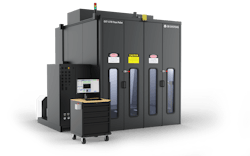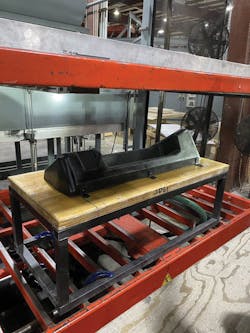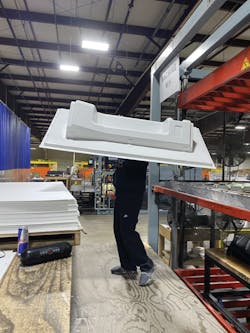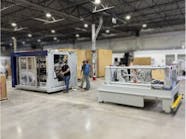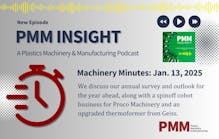Have you found an innovative equipment solution to a plastics processing challenge? Let us know.
Problem: A contract plastics thermoforming company was looking for a way to shorten lead times and reduce costs to remain competitive.
Solution: Duo Form turned to Titan 3D printers, now a division of 3D Systems Inc., for help making prototyping molds from large-format pellet-extrusion 3D printers.
By Bruce Geiselman
3D printing has allowed an Edwardsburg, Mich., thermoforming company to reduce costs and produce molds in a fraction of the time normally required.
Fifty-five-year-old Duo Form continually works to innovate its manufacturing process to remain competitive and to reduce lead times, costs and delays in the production process. At the same time, maintaining mold quality and durability is important, according to the company, which services primarily the recreational vehicle (RV) industry, as well as clients in aviation, electric vehicles, trucking, medical equipment, aviation, boating and agriculture.
In the summer of 2021, during the height of the COVID-19 pandemic and related labor problems, Duo Form reached out to executives at Titan printers, which became a part of 3D Systems, Rock Hill, S.C., in February 2022.
“They were having trouble getting thermoforming prototyping molds completed quickly,” said Clay Guillory, director at Titan, 3D Systems. He was the founder of the former Titan Additive LLC (Titan Robotics), of Colorado Springs, Colo.
When designing a new mold using traditional CNC methods, Duo Form first cut a pattern out of wood or PU board to ensure the design worked, and then it would take a transfer off of the pattern to lay up ceramic molds for production use. However, the entire procedure could take up to six weeks to get the final molds back.
“Initially, they weren’t looking for production tooling,” Guillory said. “But after some trials, they realized that the [3D printed prototype] molds weren’t breaking down. So, they were actually able to use this technology for production tooling.”
Polymer 3D printers haven’t traditionally been used for producing thermoforming molds because of the cost and speed issues associated with filament 3D printers, Guillory said. However, Titan printers use plastic pellets and extrusion technology.
Pellets speed printing process
“Normal FDM [fused-deposition-modeling] prints take a very long time, but because we are able to print with pellets and very quickly, we’re able to solve those problems, the big hurdles of cost and time for this production tooling. Instead of it being a $20,000 filament print, we’re able to do it at a few hundred dollars.”
Printing molds also is less labor-intensive than fashioning prototype molds with CNC equipment.
“It was kind of a timing issue here,” said Dave Rheinheimer, Duo Form product development manager. “We were losing two people in our mold shop. One of them had cancer and passed away in a short amount of time. … The other guy was going to retire, and the people that are here are not as versed on CNC equipment.”
Rheinheimer said he looked at several 3D printer manufacturers, but, “I connected up with Titan mainly because they had the biggest bed at the time – 50 by 50 (inches) – and that would cover a lot of what we do.”
Duo Form is using an EXT 1270 Titan Pellet printer (formerly called the Titan Atlas 3.6), and has chosen the version that includes an optional CNC spindle toolhead, allowing the 3D-printed parts to be machined to a smooth, accurate surface finish. The large print bed allows most large parts to be printed in one piece, eliminating the need for gluing.
Printing a 3D thermoforming mold, depending on the size, can typically be done in 15 to 20 hours straight without human intervention.
“There’s nobody here during the off shifts, and it just keeps printing,” Rheinheimer said. “They come in the morning, and we have a tool. … Normally, when we are doing a ceramic tool of any size, we have a four- to six-week lead time. With the 3D printer, we’re telling everybody it’ll be two weeks.”
If there is no backlog, it’s not unusual for Duo Form to be able to produce a 3D printed mold in as little as three days, he said. In addition, producing 3D printed molds costs only about 30 percent to 40 percent of what traditional ceramic mold making costs, Rheinheimer said.
Printing replaces traditional CNC process
Duo Form now 3D prints thermoforming molds using polymer pellet-extrusion on its Titan 3D printer, replacing traditional CNC methods to create ceramic or metal molds. Large-format pellet-extrusion additive manufacturing (AM) uses readily available thermoplastic pellets common to other plastics manufacturing processes like injection molding, and the pellets cost as little as one-tenth the price of traditional FDM filaments, according to 3D Systems.
3D Systems and Duo Form identified a grade of glass-filled PC pellets as ideal for printing thermoforming molds. The pellets are affordable, easily procured and proven to withstand the thermoforming process as a durable and dimensionally accurate material, according to the companies.
Heat transfer to thermoforming molds is usually minimal, Guillory said. However, if a part requires a thick plastic sheet that needs to be heated to a high temperature, 3D Systems has materials for thermoforming molds that can withstand those temperatures.
“We can avoid the problems with thick sheets by using a high-temperature material,” Guillory said. “For example, we have a nylon, and its HDT [high temperature deflection temperature] is 155 [degrees] Celsius. That’s way above what ABS would even potentially melt at. So, we have options for really thick stuff. But if you’re using a really thin sheet of PC, for example, that’s a high-temperature material, you can get away with really low-temperature molds, because it’s not transferring that much heat that fast, and the air passing through continues to cool the tool.”
The 3D printed molds are hollow, which allows for quick cooling and less heat transfer.
Duo Form also uses 3D Systems’ printing experience to achieve optimal printing parameters to create molds with the right porosity to function as vacuum passages. This unique ability of additively manufactured molds eliminates the need for special tools to properly form cavities into the thermoformed component, further reducing time and labor costs for producing molds.
Printer fills multiple roles
Duo Form doesn’t limit the use of its Titan 3D printer to producing thermoforming molds. In addition, the company uses the printer to quickly print sample parts of final products to present to customers ahead of making the tool. Directly printing parts for design approval before proceeding to the mold-making process has opened the door for faster design iteration and overall shorter lead times, according to Duo Form.
The ability to 3D print molds quickly and store digital inventory also can benefit manufacturers when it comes to storing molds, especially for products that are out of production but might be needed in the future for spare parts. With AM, a digital inventory can eliminate the need to store legacy molds, and companies can print a new mold when the need arises, Rheinheimer said.
For now, Duo Form still is producing some of its thermoforming molds using traditional CNC methods but could be increasing the use of 3D printed molds in the future. At least one of the 3D printed molds it is using is about 18 months old, has been used to produce more than 1,000 parts, and shows no wear. Duo Form still is trying to figure out just how long these 3D printed molds will last.
Some of the company's traditional ceramic molds have been in use for more than 10 years and produce thousands of parts annually.
“We are the largest leading manufacturer of ABS shower pans to the RV industry,” Rheinheimer said. “We’re shipping thousands every week.”
Bruce Geiselman, senior staff reporter
Contact:
3D Systems Inc., Rock Hill, S.C., 803-326-3930, www.3dsystems.com
Duo Form, Edwardsburg, Mich., 269-663-8525, www.duoformplastics.com
Bruce Geiselman | Senior Staff Reporter
Senior Staff Reporter Bruce Geiselman covers extrusion, blow molding, additive manufacturing, automation and end markets including automotive and packaging. He also writes features, including In Other Words and Problem Solved, for Plastics Machinery & Manufacturing, Plastics Recycling and The Journal of Blow Molding. He has extensive experience in daily and magazine journalism.
